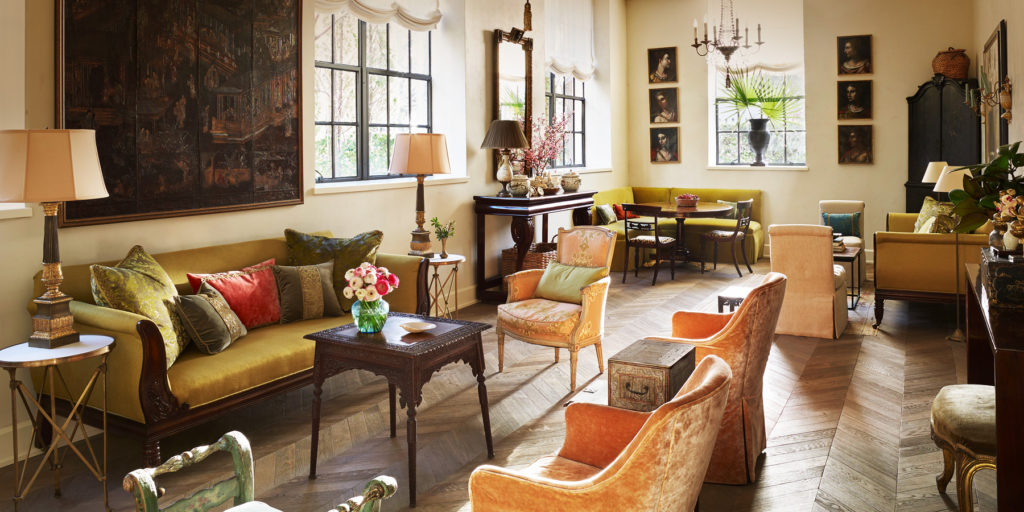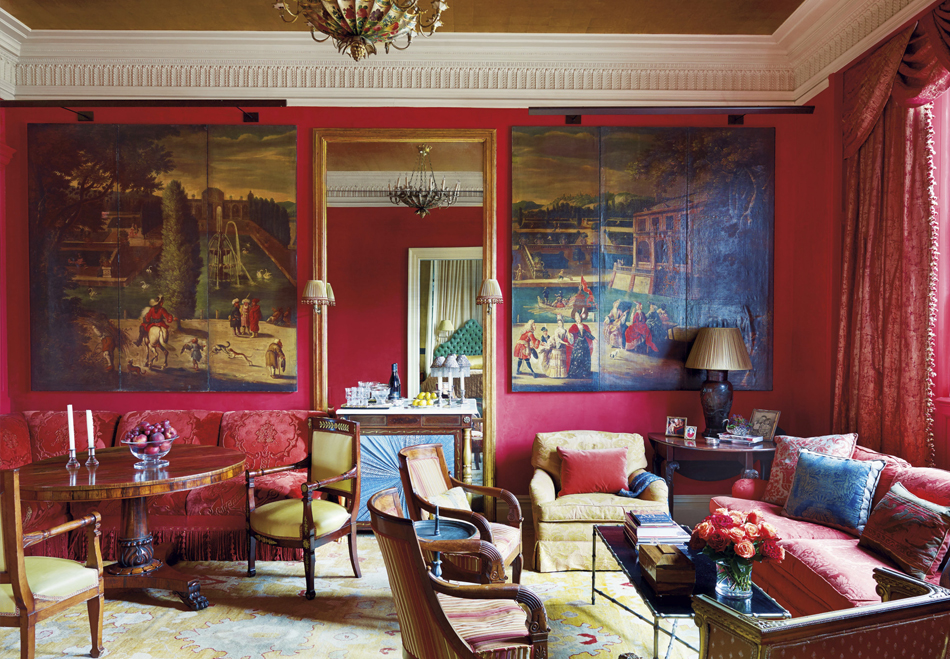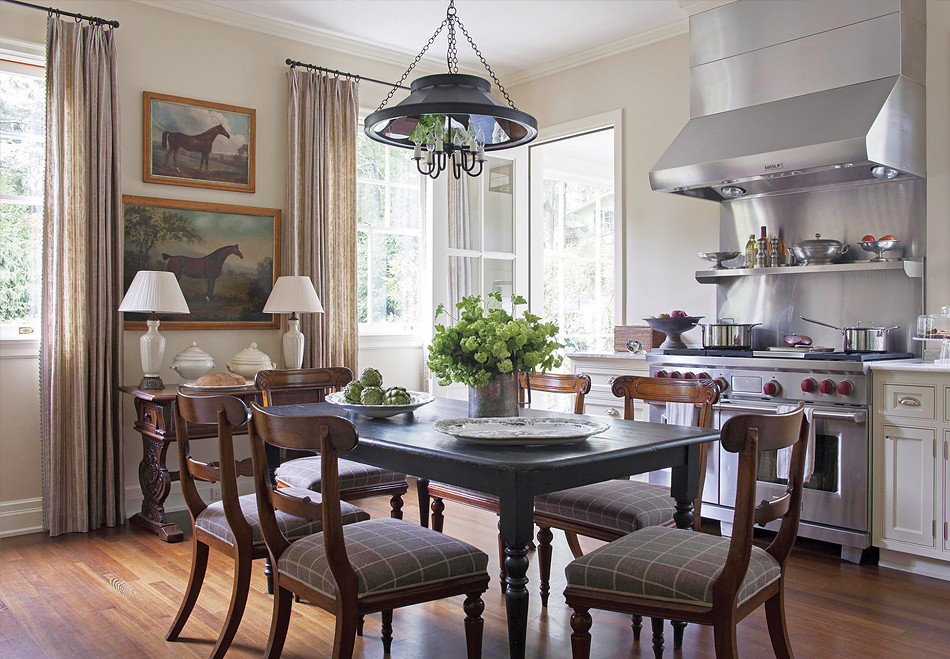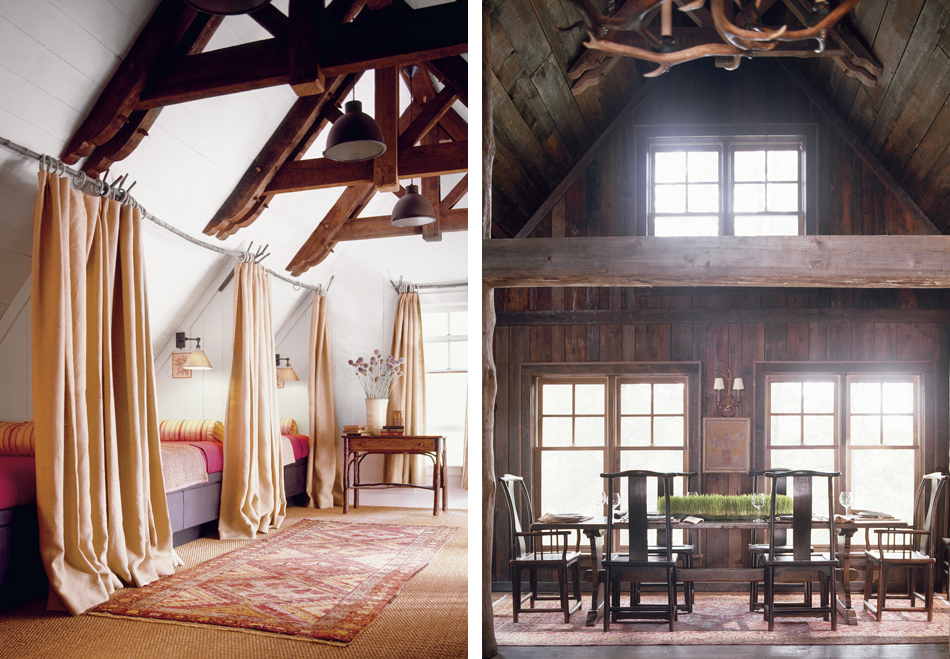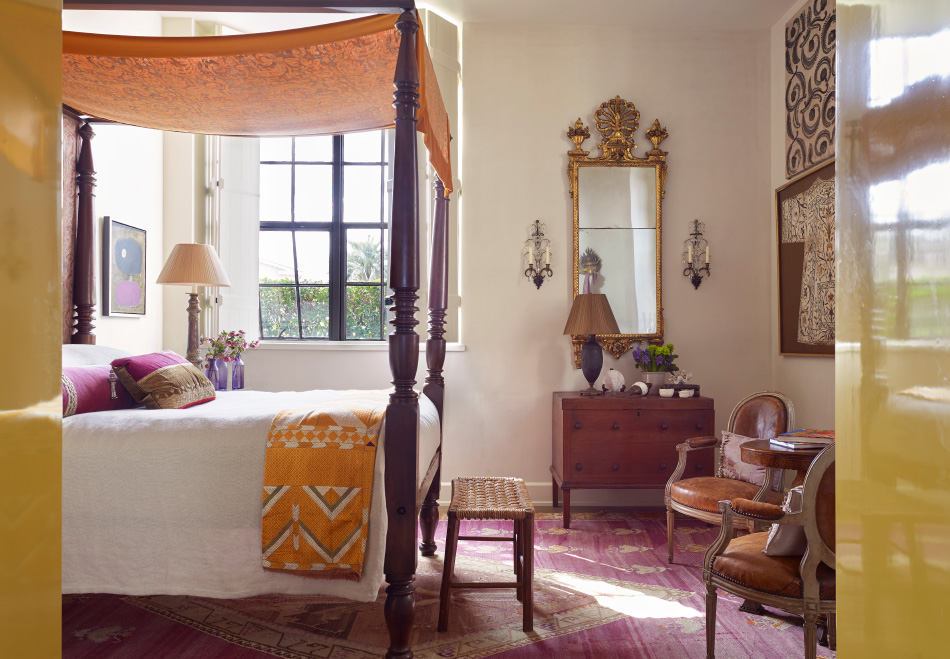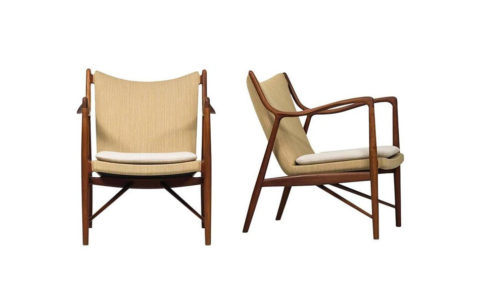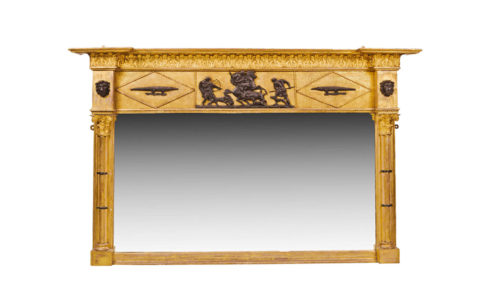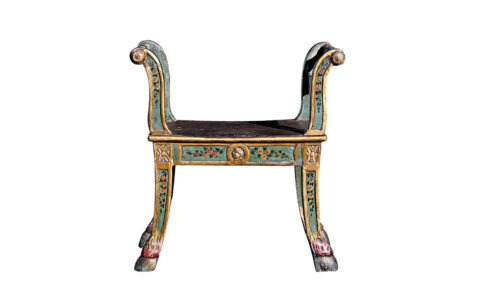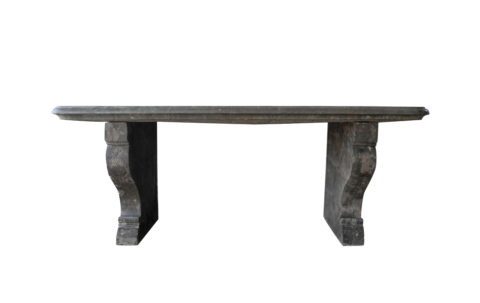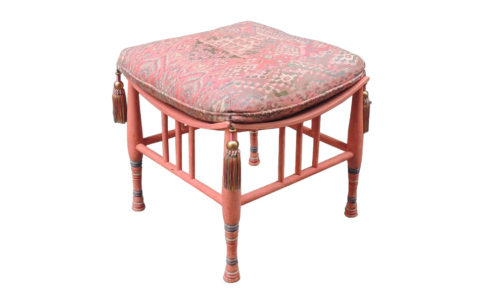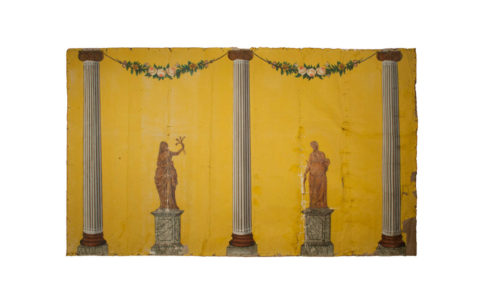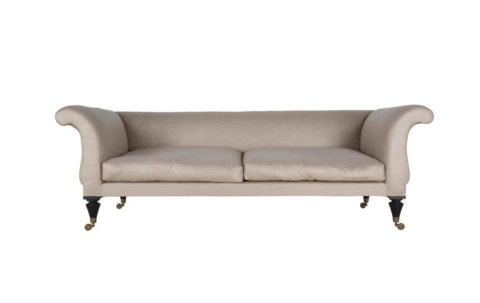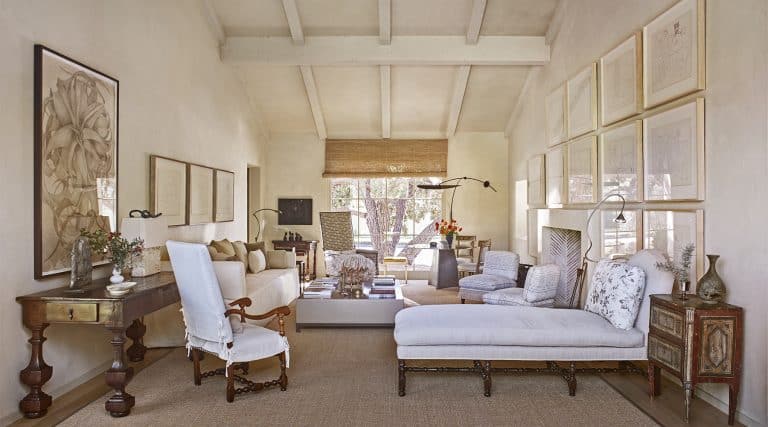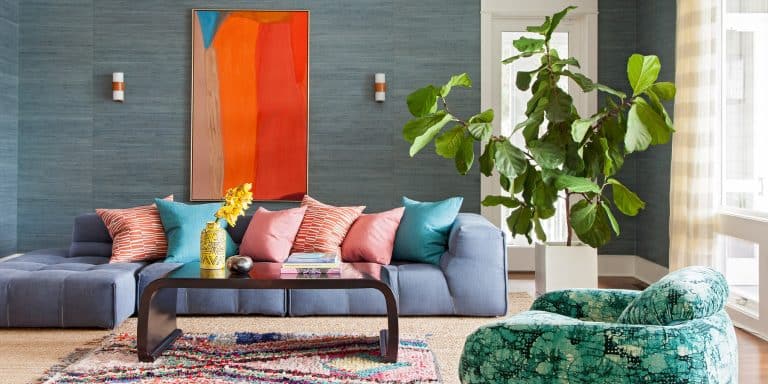
December 12, 2016Amelia T. Handegan stands in the living room of her Charleston apartment in a 1923 neoclassical revival building. The portrait above the mantel was painted in Charleston in 1756, and the chandelier is Italian. Top: Also in her living room are a pair of bergeres from her amelia, inc. line and a Swedish sofa, ca. 1820, over which hangs a coromandel screen. All photos © Pieter Estersohn, courtesy of Rizzoli, unless otherwise noted
It’s a rare teenager who would be thrilled by the gift of a stack of the Magazine Antiques, as Amelia T. Handegan was when her mother’s friend gave her more than 100 copies dating back to the 1950s. “My interest in antiques goes way back, pre-college,” says the Charleston-based interior designer, who is known for her gift as a stellar colorist and her sensitive, century-spanning combinations of antiques with modern furnishings in historic houses. The interiors she creates, for some of the grandest homes in the country owned by some of the deepest-pocketed people, are favorites of Architectural Digest and Veranda, and she’s often been included in the House Beautiful and Robb Report lists of America’s top designers.
Now, Handegan has her own lavish book, Amelia Handegan Rooms (Rizzoli), written with Ingrid Abramovitch and illustrated with exquisite photos by Pieter Estersohn. Its 224 pages contain ample evidence of Handegan’s ability to create harmonious interiors without ever striking a wrong note.
Perhaps part of her secret is a penchant for understatement. “I love quiet rooms where the windows are dressed only if needed, color is distributed in careful and even doses, and furniture is edited,” she says in the book’s introduction. Handegan’s rooms don’t scream and shout. They’re soft-spoken, gracious and easy to love.
The success of Handegan’s interiors is based on a knowledge of history applied with a light touch. “If a house has strong character, architectural detail and, most importantly, good light, you don’t need a heavy touch,” she told Introspective during a recent interview in her Charleston design studio.
The 13 homes in the book include wonders of historic preservation, like Charleston’s 1743 George Eveleigh House, a Georgian survivor in which Handegan deployed luscious apricot and golden tones; the 1772 William Gibbes house on Charleston’s Battery, whose decor Handegan updated while leaving intact 1920s additions like panoramic Zuber wallpaper and a glittering Tiffany chandelier; and Rose Hill, an 18th-century plantation house with elaborate arched plasterwork, set on 30 Virginia acres, for which she designed a new kitchen and baths as part of a full restoration.
When working on landmarks, Handegan may run with old-world decorative elements, such as hand-painted wallpaper, diamond-stenciled floors and period-appropriate antiques. These are often sourced from 1stdibs, like the circa 1815 Regency mahogany breakfront side table from O’Sullivan Antiques used in the dining room at Rose Hill and the Regency beaded-top candle stand from Golden and Associates she placed in the morning room at the Eveleigh House. The latter shares space with a pair of mid-20th-century slipper chairs by Paul McCobb for Calvin acquired from Cain Modern, presenting a perfect example of the way Handegan seamlessly introduces vintage modern elements to update a grand old house.

In a guest bedroom of the George Eveleigh House, also in Charleston, sheer curtains separate the iron four-poster from a sitting area outfitted with a vintage zebra rug and amelia, inc. slipper chairs. The wood beams and floor are original to the 1743 Georgian home.
Indeed, eclecticism — along with elegance and historicism — is a hallmark of Handegan’s style. This is evident in the venturesome red-and-gold living room of a Manhattan pied-à-terre, where she balanced damask-upholstered overstuffed seating with a trim-lined faux-bamboo coffee table from Gracie. She applies it to equally stunning effect in more rustic projects. For a family retreat in the mountains of North Carolina, created by combining three antique cabins, Handegan enhanced the structure’s weathered beauty with elements as diverse as an Oushak carpet and Chinese country chairs.
Three of Handegan’s own homes are included in the book. One is the elegant antiques-filled 1820s Greek Revival with rooms on either side of a central hall, an arrangement known in Charleston as a “double house,” where she lived for two decades and raised two sons. Also shown is the smaller loft-like apartment in a 1923 Neoclassical Revival building in Charleston into which she and her attorney husband, John Roven, moved as empty nesters a few years ago. Its high-ceilinged, white-painted rooms, free of the elaborate moldings that characterize many of her projects, are filled with a wide-ranging assortment of jewel-toned furnishings, along with textiles and carved objects from various cultures and, of course, antiques, including a circa-1805 English Regency rosewood boulle-inlay breakfast table from David Skinner Antiques. The third is an oceanfront retreat on nearby Folly Beach, to which Handegan added four bedrooms and four baths while maintaining the relaxed beach-bungalow vibe.
Handegan grew up on a South Carolina farm that had been in her family since the 18th century. She took art lessons from a Miss Evelyn Corey, whom she credits with teaching her to see colors beyond brown in the bark of a tree. “I wanted to do studio art in college, but I cannot paint,” Handegan says. Instead, she got a degree in art history and another in interior design.
“If a house has strong character, architectural detail and, most importantly, good light, you don’t need a heavy touch.”

A custom walnut desk with a leather top and a Dutch antique bronze chandelier from David Duncan Antiques are some of the traditional furnishings in the spacious library of Birdsong, a Greek Revival–style home on Wadmalaw Island, South Carolina. Photo by Max Kim-Bee

In the rear hallway of Handegan’s apartment, chartreuse-gold silk curtains frame the custom steel doors that open onto the garden. On the right wall, an antique Nathdwara school Pichwai painting of Krishna provides a rainbow of colors behind an Anglo-Indian desk.
An eye-opening trip to New York in the mid-1970s, made as part of her studies, included a visit to legendary decorator Billy Baldwin’s “chic cocoon” of an apartment. Its dark brown lacquered walls and book-filled brass étagères excited her ambitions. Baldwin’s interiors “felt absolutely modern and fresh yet were rooted in traditional design,” Handegan writes in the new book’s intro. “His rooms revealed to me that you don’t have to reject the past to create spaces that work in the present.”
With that insight, her career took off. Today, Handegan’s base is a duplex studio in a former five-and-dime store on Charleston’s not-yet-fully-gentrified Upper King Street, with office space on a mezzanine for her six employees and an array of unusual furnishings on the ground level. “I have to buy stuff when I travel, and it all comes here,” she says, gesturing toward a Swedish Gustavian cupboard and a circa-1840 Jamaican sofa, further evidence of her confidence in dealing with decorative material from a broad range of periods and cultures.
Lighting is one area in which Handegan sometimes likes to go modern, as in the kitchen at Rose Hill, where she installed a plain contemporary globe fixture. “Utilitarian light — a simple fixture that doesn’t conflict with what’s going on around it — can be a relief in a house that’s so embellished elsewhere,” she says. Other times, she will rely on 1stdibs for antique showstoppers, like the pair of French tole urn lamps from Parc Monceau Antiques used at the Pillars, a stately Greek Revival mansion in Hot Springs, Virginia; and the Dutch bronze 10-light chandelier from David Duncan Antiques placed in the library at Birdsong, a newly constructed Greek Revival–style house on South Carolina’s Wadmalaw Island.
While Handegan continues to work on historic homes of the first rank — her latest is a 1770 Federal brick townhouse once owned by Charleston artist Alfred Hutty — she herself remains modest and unpretentious. Her favorite phase of a project, she says, is not necessarily when the job is done and the accolades come rolling in.
“Sometimes, I just enjoy empty rooms, when they’re first being painted, even before the fabrics and furnishings are delivered,” she says. “I love when you see it like that, with the light coming in, and you already know how successful it’s going to be.”
Or Support Your Local Bookstore
